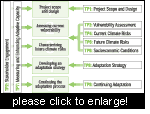 |
|
| Your
source of information on natural resources in international cooperation - focusing on agriculture, forestry and environment |
| Home | Research Service | Publications | About InfoResources | Contact | Français | Español |
| Publications > |
InfoResources News No 2 / 04 (May 2004)Special feature Special FeatureThe debate on biotechnology in agriculture
Introduction of this new technology instantly spurred a debate on its benefits and dangers. An increasing polarisation has taken place between the EU, who has a critical attitude towards genetic engineering and, correspondingly, restrictive admission regulations, and the USA, who advocate a contrary position. Environmental, consumer, and development organisations support the critical attitude, whereas biotechnology companies argue in favour of genetic engineering. A book entitled ”Genes, Trade, and Regulation” analyses the causes and the global consequences of this polarisation and discusses potential solutions. Regarding the consequences, the author is relatively pessimistic. The chances for a voluntary reconciliation are scant. On the contrary, there are many signs indicating that international controversies in trade issues are becoming increasingly harsh. While EU regulations make it practically impossible to import products containing genetically modified plants, the USA are trying to obtain by force the right to import such products freely to all countries. Developing countries are caught in the midst of these tensions. Many of Africa is under pressure. Most African countries are only just beginning to Sources: Of current interest: Policy The trade and environment debate in the WTO Although in the preamble to the 1994 Marrakesh Agreement the WTO committed itself to the objectives of sustainable development, trade and environment issues will presumably be discussed only during the next negotiation round. The urgently needed integration of environmental and trade policies is still far from realisation. Impacts of trade on the environment are manifold and complex. Their assessment requires taking into account a wide range of factors, and the ultimate question of whether the expansion of trade has a positive or a negative effect on the environment lacks any conclusive answer. Trade liberalisation urgently needs to be accompanied by an effective and consistent environmental policy framework. Today, 250 multilateral environmental agreements (MEA) exist side by side with the WTO agreements, without being able to take much influence on them. This concise article describes where the international community stands in the trade and environment debate, and indicates which issues call for action. Source: Trade and Environment in the
WTO: after Cancun. Duncan Brack, Thomas Branczik. Briefing paper No. 9. The Royal Institute of The emergence, whether planned or not, of local governments characterises the political trends at work in Latin America since 1990. The publication in question analyses the repercussions of the move towards decentralised forest management (permits, taxes, wood cutting, slash-and-burn techniques, conservation, reforestation, conflicts, non-forest related activities), based on studies of Costa Rica, Guatemala, Honduras, Nicaragua, Brazil and Bolivia. Three questions run through each country study.
To answer these questions, the authors examined the different standpoints of the main stakeholders (central governments, national institutions, legislators, municipal governments, local communities and NGOs). The Nicaragua case study, for example, shows the contradictions between forest and environmental legislation which promotes centralised management and its Municipalities Law which assigns the management of natural resources to local governments. As a result, the municipalities feel that they have been given only the burden of responsibility for environmental management and not the necessary allocation of resources, rights or benefits. This publication reveals comparative aspects which cannot be ignored in any consideration of the stakeholders involved in a democratic decentralisation process and thus promotes dialogue between them. Source: Municipal forest management in
Latin America. Ed. L. Ferroukhi.
The ”Adaptation Policy Framework” (APF) is designed to provide guidance to national teams for developing climate change adaptation policies. Unlike other approaches, the framework does not attempt to assess impact but encourages governments to develop adaptation policies. The framework is designed more like a roadmap than like a cookbook. It represents a structured approach to putting in place effective adaptation strategies, policies, and measures, in accordance with overall development goals such as poverty alleviation. However, the formulation of adaptation policies requires proactive policy decisions in critical issues across all government institutions and administration levels. Achievements made in the process will critically depend on whether the adaptive capacity of a given country can be successfully strengthened. The involvement of both national and international finance and development agencies appears to be a further essential factor. The ”User’s Guidebook,” in combination with the accompanying ”Technical Papers,” provides users with practical advice, as well as, in some instances, with methodological and technical support. The objective is to produce the following distinct outputs: Policy development, integrated assessments, project formulation. The ”Guidebook” begins with a user’s guide and a presentation of the The APF presents an opportunity for climate researchers, policy makers and other stakeholders to work in an interdisciplinary and participative manner. However, the document demands a high level of methodological discipline, as well as the ability to adapt general recommendations to the conditions of a given country. Source: The Adaptation Policy Framework: Users’ Guidebook. UNDP, GEF 2003. pp 36. www.undp.org/cc/apf.htm Of current interest: Implementation Integrated participatory forest management in Pakistan
The following are some keywords involved in this new concept in Pakistan:
Source:
Integrated participatory forest management in a densely populated
mountain region, NWFP, Pakistan. Jan Willem Nibbering & Developing countries benefit from the trade preferences of the European Sources: Jointly with partners in Mozambique and southern India, the International India is the largest importer of raw cashew nuts and the largest exporter of processed cashew nuts. In Mozambique, cashew cultivation traditionally contributes to securing food and income for small-scale farmers. The price was supported by the Government of Mozambique to protect the domestic processing industry. Due to pressure from the World Bank, Mozambique was forced to give up this policy. The World Bank hoped that the change would boost export-oriented cashew production and thus improve the income of small-scale farmers. However, the World Bank’s intervention had negative consequences. In India the demand of the processing industry for raw nuts has Source: Sustainable Agriculture and Rural Livelihoods (SARL) project summary: Project name: Liberalisation, Gender, and Livelihoods: the cashew nut case in Mozambique and India. www.iied.org/sarl/research/projects/t3proj01.html
Damage from environmental disasters is continually increasing. So far, both assessment and mitigation of dangers have predominantly been approached from a technological point of view, and measures have only partially been successful. New approaches must take account of interplay and interdependence between natural and socio-economic processes and call for rethinking concepts of risk management. This in turn requires sound knowledge of local circumstances and vulnerable areas. Hazard maps are becoming more and more important as tools to integrate physio-geographic and socio-economic information on a given region and thus form an entry point to mitigate natural and human-induced dangers and develop prevention measures. The handbook entitled ”Sistema Integrado de Gestión Ambiental” offers a methodological tool for developing integrative hazard maps for catchments in South America. Comprehensive bibliographical listings refer to useful data sources for these countries. Sources: Of current interest: Research The SAMBA Role Play Game
The SAMBA week has three objectives. First, to gain qualitative and quantitative information on natural resource use in a participatory process; secondly, to investigate into how collective institutions develop from individual actions; and thirdly, to create a communication platform based on an improved and common understanding of the complex matter of resource use. This platform can later be used for developing sustainable agriculture. Within a short time, this simulation game enables scientists to understand the complex agricultural dynamics in a northern Vietnam province characterised by a great social, economic and geographic diversity. A foundation for improved resource management is thus laid. Sources: Tavy, rain-fed rice cultivation using the slash-and-burn method, is at the very heart of society on the East Coast of Madagascar. Although blamed for deforestation, tavy is still widely practiced by the local farmers, because its production is not subject to climate changes, is less labour intensive and more likely to guarantee food security. The work examines the distinguishing features of the various types of tavy, describes their cultural characteristics which differ acording to ethnic group, and outlines the economic aspects. The analysis of the social relations linked to fire and deforestation is informative and convincing, though sometimes to the detriment of the ecological processes which are examined more superficially. The research proves to be less exhaustive than expected and – as in the case of the discussion on the contractual opportunities of community management – is clearly based on a certain ”school”. Nevertheless, this book will make very interesting reading for those interested in crop cultivation using the slash-and-burn method, and in particular project managers and decision makers who may come to exert an influence on deforestation practices in Eastern Madagascar. Source: Déforestation et systèmes agraires à Madagascar: les dynamiques des tavy sur la côte orientale. Ed. B. Aubert [et al.]. Cirad, Fofifa, Cite, 2003. 220 p. EventsGender and Forestry Symposium From 1–10 August 2004, the second International Symposium on Gender The sub-themes dealing with health, ecotourism, migration and on specific
geographical regions are promising. The event, organised by Information: www.cifor.cgiar.org/docs/_ref/events/gender_forestry/index.htm |



